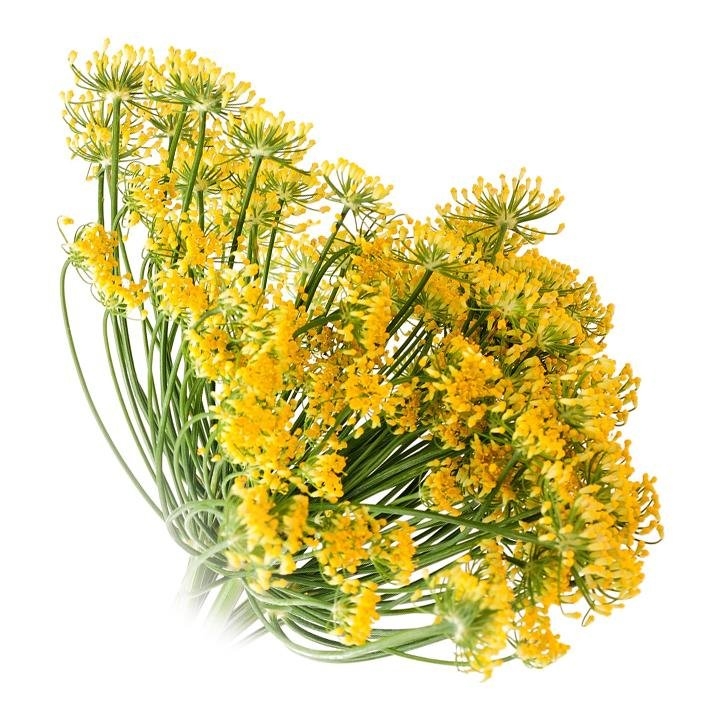Description
Herbaceous, biennial or perennial plant, up to 2 m high; hairless, very scented with a thick yellowish primary root, fusiform, most of the time bifid and with numerous secondary roots. Stem is bluish-green, erect, rounded, glabrous, glaucous and branched. It holds latex within. Leaves are very dark green, 1-5 cm long, alternate and amplexicaul with numerous lobes. The lower ones are petiolate, laciniate and filiform. The upper ones have long and well-developed sheaths. Leaves gradually turn simpler and less towards the middle and upper zones of the stem. Inflorescences are umbels of big yellow flowers, 4-8 cm diameter; 10-30 primary rays, glaucous; small flowers, up to 2 mm; normally bracts and bractlets are not present. The fruit is a brownish or greenish-red achenium, cylindrical, 3-12 mm long and 3-4 mm wide, oblong, rounded at the base and narrower at the apex. It is crowned by a wide stylopodium slightly arch-shaped. Mericarps, normally free, are glabrous and each of them shows five slightly prominent ribs. It has a characteristic anise scent and belongs to the Umbelliferae (Apiaceae) family.
It is indigenous of the Mediterranean zone and is cultivated in mild and sub-tropical weathers. Nowadays, it is easily found in Europe, Asia and some parts of Africa and South America. It grows upon river-banks, uncultivated land and fallow fields throughout Spain. Sometimes it is cultivated and other times it grows spontaneously. Blooming starts in June and harvesting from August to November, when fruits ripe and turn yellow.
Part used
Fruits and seeds. Occasionally, the root, leaves and the false ‘bulb’. It is usually eaten fresh in salads or cooked.
Indications
*Fruits
- Digestive disorders.
- Its one of the plants selected to treat intestinal disorders caused by the extended use of laxatives.
- Menstrual disorders (amenorrhea, oligomenorrhea, dysmenorrhea), menopause discomfort and hirsutism.
- Breastfeeding. Some bibliographies recommend not to use it.
- Respiratory disorders: upper respiratory tract cold, common cold, unproductive cough, bronchitis, emphysema, asthma.
- Nutrition: essential oil is used in food industry as a food flavoring, and to provide scent to food and/or seasoning as per its digestive favoring effects and pleasant scent.
- Essential oil is used in perfume and cosmetic industry as a component in tooth paste, soaps and after shave lotions.
- Eye disorders: As an eye-wash in cases of blepharitis, conjunctivitis and blepharoconjunctivitis (along with eyebright, plantain and chamomile).
- Mouth and throat disorders: gingivitis, pharyngitis, laryngitis (gargles).
*Roots
- Genitourinary disorders: cystitis, uretheritis, urethritis, pyelonephritis, oliguria, urolithiasis.
- Hyperazotemia, hyperuricemia, gout.
- Blood flow hypertension.
- Edemas, overweight with water retention.
Bibliography
Real Farmacopea Española, 2ª edición. 2002.
Farmacopée Française IX Édition.
British Herbal Pharmacopoeia, 1983.
Herbal Drugs and Phytopharmaceuticals. Norman Grainger Bisset (Ed). Max Wichtl. CRC Press.1994.
Plantas Medicinales y Drogas Vegetales para infusión y tisana. Edición española a cargo de: Salvador Cañogueral, Roser Vila, Max Wichtl.1998.
Plantas Medicinales. Thérapeutique-Toxicité. Christiane Vigneau. Masson, Paris 1985.
Plantas Medicinales. Margarita Fernandez y Ana Nieto. Ed Universidad de Navarra. EUNSA 1982.
Fitoterapia: Vademecum de Prescripción. Plantas Medicinales. Colaboran: Asociación española de médicos naturistas. Colegio Oficial de Farmacéuticos de Vizcaya.
Matière Médicale (tomo II). RR Paris- H. Moyse. Masson 1981.
The Complete German Commission E Monographs. Therapeutic Guide To Herbal Medicines. Mark Blumenthal. American Botanical Council 1998.
Fitoterapia Aplicada. J.B. Peris, G. Stübing, B.Vanaclocha. Colegio Oficial de Farmacéuticos de Valencia 1995.
Pharmacognosy, Phytochemistry, Medicinal Plants. Jean Bruneton. Lavoisier Publishing.
Plantas Medicinales. El Dioscórides Renovado. Pio Font Quer.
Guía de Campo de las Flores de Europa. Oleg Polunin. Ediciones Omega S.A. Barcelona, 1977.
Pharmacognosy 9th edition.Varro E. Tyler – Lynn R. Brady – James E. Robbers.
Jean Bruneton. Farmacognosia. Fitoquímica Plantas Medicinales. 2ª Edición. 2001. Ed Acribia. S.A.
Bulletin officiel Nº 90/22 bis" del "Ministère des Affaires Sociales et de la Solidarité, Médicaments a base de Plantes.
French Public Health Code.
